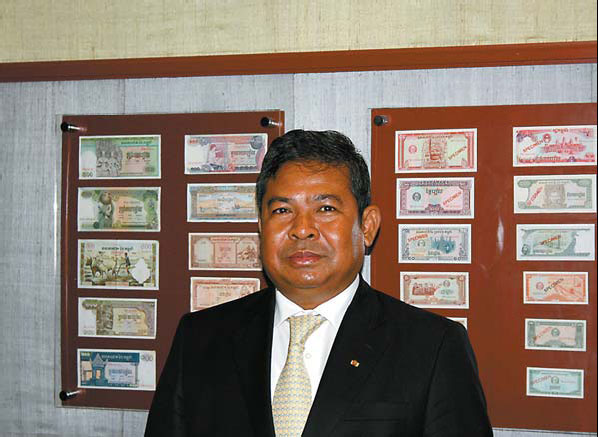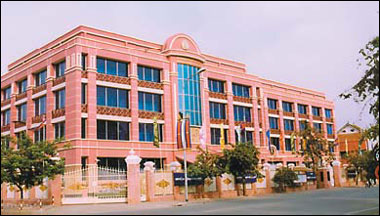National Bank committed to country's growth
|
Mr Chea Chanto, governor of the National Bank of Cambodia |
As Cambodia enjoys a time of peace, stability and economic growth, the National Bank of Cambodia welcomes international banks to enter and operate within the country, as well as set up joint ventures or strategic partnerships in Cambodia with local banks or businesses, said Mr Chea Chanto, governor of the National Bank of Cambodia, in an interview with China Daily.
Brief history of the Bank
Cambodia has undergone several changes in political regime during its turbulent recent history.
During that time, there was no market and no education system. People were forcibly evacuated from the cities to the countryside to work collectively.
After liberation in 1979, the authorities first tried to restore the country with any means possible to allow the markets and the economy to grow, solve the problems left by the regime and rehabilitate the country as a whole.
It was at this time that Heng Samrin, the president of the People's Revolutionary Council, assigned Chea Chanto, together with other leaders of the National Bank of Cambodia, to re-establish the bank and make it operational once again in order to provide services to the people.
In October 1979, the National Bank of Cambodia was reopened and in March 1980, the new bank note was put into circulation.
|
The National Bank of Cambodia |
Prior to this, a barter system was used to obtain goods and services, even though it was the 20th century. The government printed currency and put it into circulation initially to pay salaries to government workers or civil servants. A kind of mono-banking system was established, which is a system where the Central Bank plays the role of treasurer to the government, but at the same time is the provider of banking services to the economy, taking deposits and providing loans to private individuals and economic agents.
In 1989, the country began the process of economic reform and the entry of private and foreign investors to Cambodia began. By 1992, the first of Cambodia's commercial banks were opening such as the Cambodia Commercial Bank (CCB) and the local Canadia Bank.
More and more private commercial banks opened as the country's economy opened up further from 1993.
In 1996, the National Assembly propagated a new Central Bank law, according to which the National Bank became an independent institution within the country. Since then, the country began to strengthen the whole banking system and made a shift to a market economy.
The National Bank of Cambodia acts as the supervisory authority and the private commercial banks are the market players or service providers. The National Bank of Cambodia subsequently withdrew its equity participation from some of the commercial banks.
In 1999, the law on banking and financial institutions was propagated. Based on the new "commercial bank law" of 1999, the country started to clean up the banking sector, in the so-called "re-licensing process".
The process led to an improvement of the entire banking sector, in turn creating a substantial increase in the confidence of the general public as well as of international and local investors.
Current situation
Cambodia's central bank is the National Bank of Cambodia, which has branch offices in various cities and provinces. Its main responsibility is acting as the supervisory authority for the banking sector. It is also the organization responsible for tackling and setting monetary policy.
Besides, there are 18 commercial banks, 7 specialized banks and numerous micro-finance institutions operating in the Cambodian countryside.
The banking sector is showing steady growth and its total assets grew 74.2 percent at the end of 2007, while its deposit base grew 74.5 percent in the same period. Credit to the private sector also grew by 80.3 percent during the period.
In 2006, the banking sector contributed approximately $500 million in financing to various domestic projects. Credit to the rural poor through micro-finance institutions is also on the rise.
More than 500,000 households have used micro-finance services and the proportion of non-performing loans is very low at below 1 percent.
This is an indication of the level of development within the Cambodian banking sector. Prime Minister Hun Sen has proclaimed 2006 to be the Year of Micro-Finance in Cambodia.
Rural credit is expected to contribute to the ultimate goal of the government - poverty alleviation. The government hopes that only 15 percent of the population will still live below the poverty line by 2015, which means pushing down the poverty line by at least 1 percent every year.
Banking sector's evolution
The process of strengthening the Central Bank began in 1996 and was accelerated in 1998. Reorganizing the National Bank of Cambodia and building up human resource capacity were the first two steps in this regard.
The bank received support from a number of institutions including the International Monetary Fund (IMF), Asian Development Bank, the French Central Bank and Germany's Bundesbank and so on.
The bank is also building up the capacity of its General Inspection Group, a unit responsible for internal control and inspection to ensure everything is in order within the bank through internal controls and audit.
Besides the internal controls, the National Bank has the financial reports independently checked by an external auditor and has safeguard assessments done by the IMF, which provides a role model for other institutions.
The National Bank of Cambodia is also paying close attention to trying to strengthen the Bank Supervision Department in order to build human capacity and technical competence. It is a challenge for the bank to train and develop the teams of bank supervisors so that they in turn can supervise other commercial banks.
The banking sector in particular, and the finance sector in general, are now more or less internationally integrated and have standardized operations, products and services. The education system is also improving steadily. A great deal of help has been provided by the IMF in the process of language training and in the training of the bank supervisors.
The Cambodian National Assembly has propagated the Law on Anti-money Laundering and Combating the Financing of Terrorism in June last year. The National Bank also joined the Asia Pacific Group (APG) on anti-money laundering and financing terrorism, which is regarded as a sign of the government and Central Bank of Cambodia's dedication to fighting money laundering and terrorism financing.
International cooperation
The National Bank of Cambodia sees China as one of the important parts of Cambodia's future growth, that of its banking sector in particular.
Though the number of Chinese investors in Cambodia is not too high yet, China has, through its government channels, helped build up infrastructure in Cambodia through direct support. In terms of China, Cambodia has bilateral investments through official aid. Future Chinese investment in Cambodia will depend on the interests of the Chinese banks.
The National Bank is attracting investment and more banking interest from China and from other major international banking institutions. There will be more big banks entering Cambodia as the economy and the banking sector grow.
(China Daily 04/10/2008 page27)
















